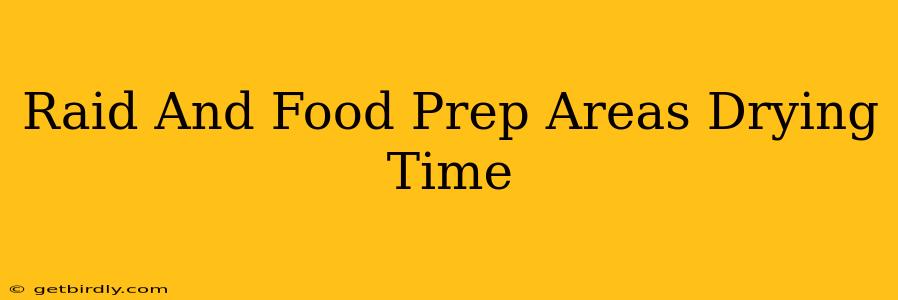Raid and Food Prep Areas: Drying Time – A Comprehensive Guide
Maintaining a clean and sanitary kitchen is crucial for preventing foodborne illnesses and ensuring a healthy environment. After using insecticides, like Raid, in your kitchen, particularly near food preparation areas, a critical question arises: how long do these areas need to dry before resuming food preparation? This guide will delve into the drying times required for different surfaces and provide crucial safety information.
How Long Does Raid Take to Dry?
The drying time for Raid, or any insecticide spray, isn't a fixed number. It depends heavily on several factors:
- Type of Surface: Porous surfaces like wood or certain types of countertops will absorb the insecticide more slowly than non-porous surfaces like stainless steel or sealed granite.
- Amount of Spray: Over-spraying will naturally extend the drying time. Always follow the product instructions for application.
- Ventilation: Good ventilation accelerates evaporation. A well-ventilated area will dry much faster than a poorly ventilated one.
- Temperature and Humidity: Higher temperatures and lower humidity will lead to faster drying.
While the product label might not specify an exact drying time, a general rule of thumb is to allow at least 30 minutes to several hours for complete drying, depending on the factors listed above. However, err on the side of caution. It's always better to wait longer than risk contaminating food preparation areas.
What Surfaces Need Extra Drying Time?
Porous surfaces like wooden cutting boards or untreated wooden countertops require considerably more drying time than non-porous surfaces. The insecticide can seep into the wood, potentially contaminating food later. Consider wiping these surfaces down with a damp cloth after the initial drying period to remove any lingering residue.
How to Ensure Complete Drying After Using Raid:
- Ventilation: Open windows and doors to improve airflow. Using a fan can further speed up the drying process.
- Proper Application: Follow the instructions on the Raid product label carefully. Avoid overspraying.
- Waiting Period: Allow ample time for drying – at least 30 minutes, but preferably longer, especially for porous surfaces.
- Thorough Wiping (Porous Surfaces): After the initial drying period, wipe down porous surfaces with a damp cloth.
- Inspection: Before resuming food prep, carefully inspect the areas treated with Raid. If you still detect a lingering odor or feel any residue, wait longer.
What Happens If I Don't Wait Long Enough?
Failing to allow sufficient drying time after using Raid in food prep areas can lead to several problems:
- Food Contamination: Insecticide residue can transfer to food, potentially causing illness.
- Unpleasant Taste or Odor: The lingering insecticide may impart an unpleasant taste or odor to your food.
- Health Risks: Direct contact with insecticide residue can pose health risks, particularly for sensitive individuals.
Can I Use Raid Near Food Prep Areas?
Ideally, it's best to avoid using insecticides in areas where food is prepared. Effective cleaning and preventative measures, such as proper storage of food and regular pest control, are far safer and more effective long-term solutions. However, if insecticide use is absolutely necessary, strictly follow the instructions and take all precautions outlined above to minimize risk.
Are there Alternatives to Raid for Kitchen Pest Control?
Yes, many safer alternatives exist for kitchen pest control. Consider using natural pest repellents like peppermint oil, diatomaceous earth (food-grade), or calling a professional pest control service for a long-term solution.
How to Clean After Using Raid in Food Prep Areas?
After the drying period, thoroughly clean all surfaces with hot, soapy water. Rinse well and allow to air dry completely.
This guide provides comprehensive information about drying times and safety precautions concerning the use of insecticides, such as Raid, near food prep areas. Remember, prioritizing safety and hygiene is paramount when dealing with any pest control measures in your kitchen. Always prioritize safe and effective preventative measures to minimize the need for insecticides.

